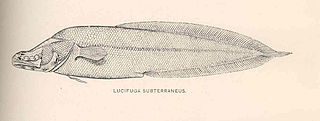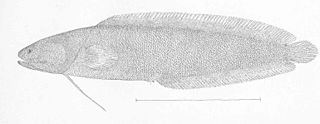| Viviparous brotulas | |
|---|---|
 | |
| Hephthocara simum | |
| Scientific classification | |
| Domain: | Eukaryota |
| Kingdom: | Animalia |
| Phylum: | Chordata |
| Class: | Actinopterygii |
| Order: | Ophidiiformes |
| Family: | Bythitidae T. N. Gill, 1861 |
| Subfamilies | |
See text | |
The viviparous brotulas form a family, the Bythitidae, of ophidiiform fishes. They are known as viviparous brotulas as they generally bear live young, [1] although there are indications that some species (at least Didymothallus criniceps ) do not. [2] They are generally infrequently seen, somewhat tadpole-like in overall shape and mostly about 5–10 cm (2–4 in) in length, [1] but some species grow far larger and may surpass 60 cm (2 ft). [3] [4]
Although many live near the coast in tropical or subtropical oceans, [1] there are also species in deep water and cold oceans, for example Bythites . [5] Thermichthys hollisi , which lives at depths of around 2,500 m (8,200 ft), is associated with thermal vents. [6] A few are fresh or brackish water cavefish: the Mexican blind brotula (Typhliasina pearsei), Galapagos cuskeel (Ogilbia galapagosensis), Diancistrus typhlops and some Lucifuga species. [2] [7]
Since 2002, more than 110 new species have been added to this family. [8] In 2005, 26 new species were described in a single paper by Danish and German scientists [9] and in 2007, an additional eight new genera with 20 new species were described in another paper by the same scientists. [10]
In some classifications the family Aphyonidae is placed within the Bythitidae and the tribe Dinematichthyini of the subfamily Brosmophycinae has been raised to the status of a family, the Dinematichthyidae which contains 25 genera and 114 species. [11]
The Bythitidae is divided as follows:
- Subfamily Brosmophycinae
- Tribe Dinematichthyini
- Alionematichthys
- Beaglichthys
- Brosmolus
- Brotulinella
- Dactylosurculus
- Dermatopsis
- Dermatopsoides
- Diancistrus
- Didymothallus
- Dinematichthys
- Dipulus
- Gunterichthys
- Lapitaichthys
- Majungaichthys
- Mascarenichthys
- Monothrix
- Nielsenichthys
- Ogilbia
- Ogilbichthys
- Paradiancistrus
- Porocephalichthys
- Typhliasina
- Ungusurculus
- Zephyrichthys
- Tribe Brosmophycini
- Tribe Dinematichthyini
- Subfamily Bythitinae




